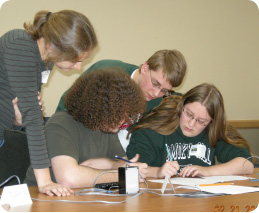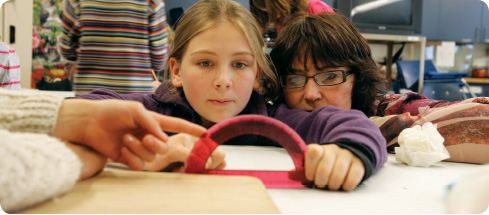Science ‘n’ Schools Symbiosis
CIRES Education and Outreach program creates win-win projects for all involved.
Scurrying around on school rooftops collecting rainwater might seem an unlikely introduction to real science, but for some Colorado  middle-school students, it’s a unique opportunity, not just to learn about conducting an experiment, but also to contribute to a critical research study: investigating how water circulates in the atmosphere.
middle-school students, it’s a unique opportunity, not just to learn about conducting an experiment, but also to contribute to a critical research study: investigating how water circulates in the atmosphere.
“Understanding how water moves around in the air—the water cycle—will help us know how to use water more effectively for agriculture, environmental sustainability, and recreation,” said CIRES Fellow and project leader David Noone, “and this project is not really possible without making use of citizen science—in this case, the help of students.”
The nearly 200 students collect the rainwater that falls on school rooftops, and the researchers analyze the samples’ water chemistry to determine where the water has come from and eventually what its fate will be, Noone said. The scientists and students also run weather stations across the experimental region in the St. Vrain Valley School District to record vital statistics, such as rainfall amount, temperature, humidity, and wind speed, that influence the water cycle.
The students’ assistance means the team can gather data from a number of locations, thereby gauging a more accurate representation of the region as a whole, Noone said. “We gain this network perspective on the region,” he said. “Working together gives us something that is greater than the sum of its parts.”
The project is one of many facilitated by the CIRES Education and Outreach (EO) program since its inception in 1996. The program’s goal is to use CIRES scientific expertise to encourage curiosity and awareness of the natural environment in learners and to impact science education at all levels.
“CIRES includes a great treasure trove of scientists and scientific knowledge,” says EO Director Susan Buhr. “Through outreach, we can help to get this knowledge out to people who will use it or participate in it.”
The program’s coordinators oversee many projects such as facilitating volunteer opportunities for scientists in schools and the community, and providing training for classroom teachers in the environmental sciences. However, the group’s mission is not only to connect science to society but also to marry expert scientific knowledge in CIRES with lesson plans for K-12 school students that are scoped with correct learning pedagogy, said former CIRES Director Susan Avery, who initiated the program.
“I wanted CIRES to treat education and outreach as a science,” said Avery. “Doing so was yet another interdisciplinary effort within the institute, and it expanded CIRES’s horizons.” Because of this desire, EO focuses on initiatives that are shown to have a compelling impact on education, such as increasing teacher confidence with scientific research findings, providing access to high- quality learning resources, and helping children to think scientifically, Buhr says. Also CIRES EO has an evaluation team to ensure that projects use evidence to guide development and decision-making, Buhr says.
Noone, who has previously given talks both in schools and in the local community about his research, sees outreach work as raising awareness about important environmental issues such as the role of water in society. He also hopes that his enthusiasm for science will inspire students to consider careers in science.
 “I really enjoy science. I think it is really exciting, and I hope to share that with people,” Noone said. “It is just a lot of great fun.”
“I really enjoy science. I think it is really exciting, and I hope to share that with people,” Noone said. “It is just a lot of great fun.”
Currently, Noone is working with three schools, and this year the project will expand to 10, enabling the scientists to collect samples across the district, the country, or potentially even internationally, he said.
“It is a case of win-win,” Noone said. The scientists need extensive data networks, and the project provides students valuable learning opportunities, he said.
“We help the students, and the students help us,” he said.



